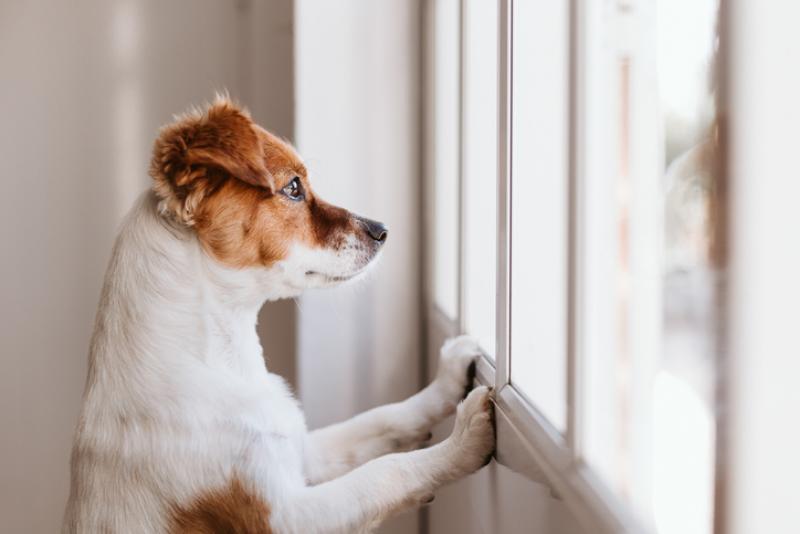
Dogs can become overwhelmed and anxious when they’re left alone.
This behaviour is known as separation anxiety and can lead to excessive barking, destroying furniture and an unhappy pet. Thankfully, separation anxiety is a manageable condition.
Below, we define separation anxiety, discuss why some dogs have it and share how to treat it.
What’s separation anxiety?
Dogs are sociable animals; they don’t like living alone.
As pets, their family becomes their pack, and they can show signs of anxiety when separated from them. This behaviour is separation anxiety.
These signs range from mild to severe, and you may not even realise your pet has it. RSPCA figures estimate that 85% of dogs struggle with the condition, around 7 million in the UK.
How do I know if my dog has separation anxiety?
A severe case of separation anxiety is easier to detect in a dog, and signs to look out for include:
- excessive barking
- howling
- chewing furniture
- toileting indoors
- uneaten food
- drooling
Milder cases are hard to identify. Signs include:
- pacing
- panting
- tense posture
- lip licking
- pinned-back ears
- tail between legs
- yawning
You can set up a camera to see your dog’s actions when they’re left alone if you’re concerned.
How to identify the source of anxiety
Anxiety usually has three causes:
Frustration
A dog will feel frustrated if it can’t get what it needs. Passing wildlife or cats may spike your dog’s attention, or it may become jealous of other dogs getting walked.
Fear and anxiety
Dogs can fear loneliness, which is the primary cause of separation anxiety. Things get worse when they recognise your routine for leaving the house like grabbing your keys or putting on shoes.
Boredom
Sometimes, a dog’s separation anxiety is just boredom; exercising them earlier in the day or giving them something to do when home alone could help. If their symptoms stop after this, then the dog was bored.
Hiring a dog walker can keep your dog happy at home too.
Why do some dogs suffer more from separation anxiety?
Some dogs suffer more from anxiety due to a lack of training. Owners need to teach dogs how to be happy on their own as it’s not in their nature.
This is best done from a young age, and canine behaviourists recommend that you gradually build up the amount of time a dog is left alone. Dogs need to associate separation with something good.
Proper training helps.
How to train a dog to tackle separation anxiety
Overcoming separation anxiety takes time. Prevention is better than a cure, so you should slowly increase your dog’s alone time. Pet behaviour expert Leon Towers suggests the following to help keep a dog happy when they’re alone:
Crate training
Crate training is introducing a puppy or a dog to a kennel or crate. This gives your dog a “safe space” where they can feel secure when they’re feeling anxious. Learn how to crate train a dog.
Don’t make a fuss when leaving the house
Making a fuss over your dog before you leave can spike their anxiety. Leave the room or house calmly; don’t turn it into a big event.
Give your dog a toy
A suitable toy can keep a dog occupied, which reduces boredom and stress.
Don’t let your puppy follow you everywhere
Have some boundaries. Allowing your dog to follow you everywhere can lead to co-dependency.
Don’t assume getting another dog will help
Your pet could have developed a particularly strong attachment to you, so simply expanding the pack won’t make up for your absence.
Use background noise
Background noise can be useful for some dogs that get anxious in the home on their own. You could try leaving a radio or television on for them or a relaxing music playlist.
A study by Colorado State College of Veterinary Medicine in 2012 showed that classical music had a significant calming effect on shelter dogs.
You must change a dog’s perspective of being alone – associating it with something fun instead of something scary and improve its confidence.
How long should I leave my dog home alone?
The RSPCA advises against leaving a dog alone for longer than four hours.
Dealing with severe separation anxiety
Seek professional help from your vet or a good canine behaviourist if your dog has severe separation anxiety.
Remember: patience is important, so you don’t cause your pet any additional stress. Never punish your dog for anything they do while stressed.
For example, toileting in the house or scratching at doors. You’ll only make things worse, and you could damage the bond between you.
With guidance from a professional behaviourist – along with time, patience and love – you’ll see a wagging tail when you leave home, not just when you return.
I’ve spent 20 years writing about pets and exploring the wonderful relationships they have with their owners. I started as a staff writer on Dogs Today magazine, working my way up to become deputy editor in 2008. In 2010, I left the office to pursue a freelance career, relocated to north Norfolk and started a family.
Over the years I’ve contributed thoughtful human-interest features, celebrity interviews and investigative news stories to publications including The Sunday Times, Dogs Today, Dogs Monthly and Your Cat. I’ve also ghost-written veterinary books and press releases for the pet industry.
When I’m not writing, I enjoy long walks in the Norfolk countryside with my rescue lurcher Popsie. These are always followed by tea and cake.




